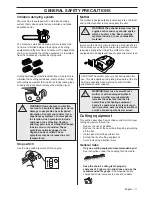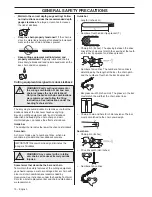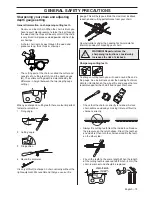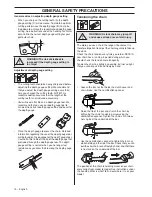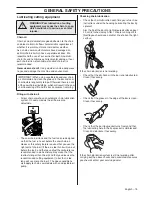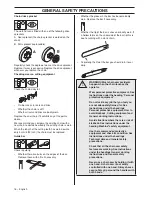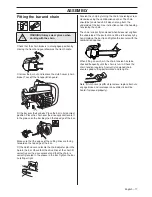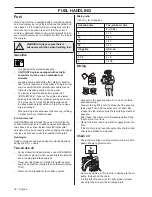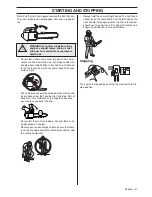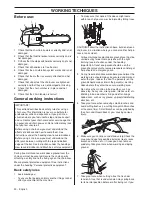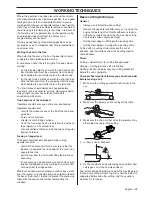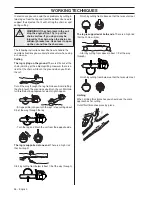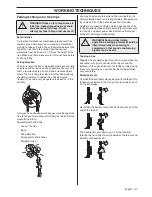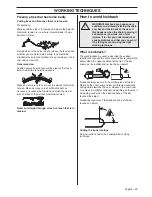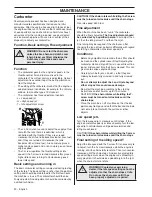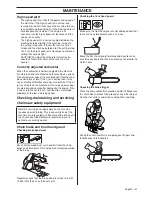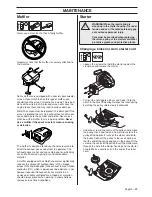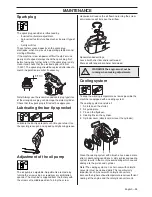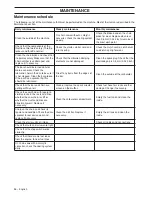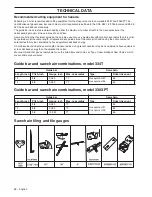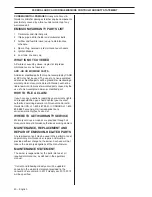
WORKING TECHNIQUES
English
–
25
Where the operator is working close into vertical stems
with a low lateral forces on their work position, then a good
footing may be all that is needed to maintain a secure
work position. However as operators move away from the
stem, they will need to take steps to remove or counteract
the increasing lateral forces by, for example, a re-direct of
the main line via a supplementary anchor point or using
an adjustable strop direct from the harness to a
supplementary anchor point.
Gaining a good footing at the working position can be
assisted by use of a temporary foot stirrup created from
an endless sling.
Starting the saw in the tree
When starting the saw in the tree, the operator should:
a) apply the chain brake before starting.
b) hold saw on either the left or right of the body when
starting:
1
on the left side hold the saw with the left hand on the
front handle and thrust the saw away from the body
while holding the pull starter cord in the other hand.
2
on the right side, hold the saw with the right hand on
either handle and thrust the saw away from the body
while holding the pull starter cord in the left hand.
The chain brake should always be engaged before
lowering a running saw onto its strop. Operators should
always check the saw has sufficient fuel before
undertaking critical cuts.
One-hand use of the chainsaw
Operators should never use a chain saw onehanded.
Operators should never:
•
cut with the kickback zone at the tip of the chainsaw
guide bar
•
‘hold and cut’ sections.
•
attempt to catch falling sections.
•
Cut in the tree when he/she is only secured with one
rope, always use 2 secured lines.
•
check condition of harness, belt and ropes at regular
frequent intervals.
Freeing a trapped saw
If the saw should become trapped during cutting,
operators should:
•
switch off the saw and attach it securely to the tree
inboard (i.e. towards the truck side) of the cut or to a
separate tool line.
•
pull the saw from the kerf whilst lifting the branch as
necessary.
•
if necessary, use a handsaw or second chain saw to
release the trapped saw by cutting a minimum of 30
cm away from the trapped saw.
Whether a handsaw or a chainsaw is used to free a stuck
saw, the release cuts should always be outboard (toward
the tips of the branch), in order to prevent the saw being
taken with the section and further complicating the
situation.
Basic cutting technique
General
•
Always use full throttle when cutting!
•
Reduce the speed to idle after every cut (running the
engine for too long at full throttle without any load, i.e.
without any resistance from the chain during cutting,
can lead to serious engine damage).
•
Cutting from above = Cutting with a pulling chain.
•
Cutting from below = Cutting with a pushing chain.
Cutting with a pushing chain increases the risk of
kickback. See instructions under the heading How to
avoid kickback.
Terms
Cutting = General term for cutting through wood.
Limbing = Cutting branches off a felled tree.
Splitting = When the object you are cutting breaks off
before the cut is complete.
There are five important factors you should consider
before making a cut:
1
Make sure the cutting equipment will not jam in the
cut.
2
Make sure the object you are cutting will not split.
3
Make sure the chain will not strike the ground or any
other object during or after cutting.
4
Is there a risk of kickback?
5
Do the conditions and surrounding terrain affect how
safely you can stand and move about?
Two factors decide whether the chain will jam or the object
that you are cutting will split: the first is how the object is
supported before and after cutting, and the second is
whether it is in tension.

